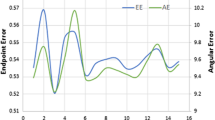Abstract
This paper addresses the human action recognition task from optical flow. We develop a non-parametric motion model using only the image region surrounding the actor making the action. For every two consecutive frames, a local motion descriptor is calculated from the optical flow orientation histograms collected from overlapping regions inside the bounding box of the actor. An action descriptor is built by weighting and aggregating the estimated histograms along the temporal axis. We obtain a promising trade-off between complexity and performance compared with state-of-the-art approaches. Experimental results show that the proposed method equals or improves on the performance of state-of-the-art approaches using these databases.
Preview
Unable to display preview. Download preview PDF.
Similar content being viewed by others
References
Moeslund, T., Hilton, A., Krüger, V.: A survey of advances in vision-based human motion capture and analysis. Computer Vision and Image Understanding 104, 90–126 (2006)
Aggarwal, J., Cai, Q.: Human motion analysis: A review. Computer Vision and Image Understanding 73(3), 428–440 (1999)
Gavrila, D.: The visual analysis of human movement: A survey. Computer Vision and Image Understanding 73(1), 82–98 (1999)
Moeslund, T., Granum, E.: A survey of computer vision-based human motion capture. Computer Vision and Image Understanding 81(3), 231–268 (2001)
Bruhn, A., Weickert, J., Schnörr, C.: Lucas/Kanade meets Horn/Schunck: Combining local and global optic flow methods. International Journal of Computer Vision 61(3), 211–231 (2005)
Brox, T., Bruhn, A., Papenberg, N., Weickert, J.: High accuracy optical flow estimation based on a theory for warping. In: Pajdla, T., Matas, J(G.) (eds.) ECCV 2004. LNCS, vol. 3024, pp. 25–36. Springer, Heidelberg (2004)
Lucas, B., Kanade, T.: An iterative image registration technique with an application to stereo vision. In: Proceedings of DARPA IU Workshop, pp. 121–130 (1981)
Farnebäck, G.: Two-frame motion estimation based on polynomial expansion. In: Bigun, J., Gustavsson, T. (eds.) SCIA 2003. LNCS, vol. 2749, pp. 363–370. Springer, Heidelberg (2003)
Efros, A., Berg, A., Mori, G., Malik, J.: Recognizing action at a distance. In: IEEE International Conference on Computer Vision, vol. 2, pp. 726–733 (2003)
Otsu, N.: A threshold selection method from gray level histograms. IEEE Trans. Systems, Man and Cybernetics 9, 62–66 (1979)
Blank, M., Gorelick, L., Shechtman, E., Irani, M., Basri, R.: Actions as space-time shapes. In: Proceedings of the IEEE International Conference on Computer Vision (ICCV 2005), vol. 2, pp. 1395–1402 (2005)
Schüldt, C., Laptev, I., Caputo, B.: Recognizing human actions: A local SVM approach. In: International Conference on Pattern Recognition, Cambridge, U.K., vol. 3, pp. 32–36 (2004)
Dollar, P., Rabaud, V., Cottrell, G., Belongie, S.: Behavior recognition via sparse spatio-temporal features. In: 2nd Joint IEEE International Workshop on Visual Surveillance and Performance Evaluation of Tracking and Surveillance, pp. 65–72 (2005)
Laptev, I., Marszalek, M., Schmid, C., Rozenfeld, B.: Learning realistic human actions from movies. In: Intern. Conference on Computer Vision and Pattern Recognition (2008)
Ahmad, M., Lee, S.: Human action recognition using shape and clg-motion flow from multi-view image sequences. Pattern Recognition 41, 2237–2252 (2008)
Zelnik-Manor, L., Irani, M.: Statistical analysis of dynamic actions. IEEE Transaction on Pattern Analysis and Machine Intelligence 28(9), 1530–1535 (2006)
Ikizler, N., Duygulu, P.: Human action recognition using distribution of oriented rectangular patches. In: Elgammal, A., Rosenhahn, B., Klette, R. (eds.) Human Motion 2007. LNCS, vol. 4814, pp. 271–284. Springer, Heidelberg (2007)
Author information
Authors and Affiliations
Editor information
Editors and Affiliations
Rights and permissions
Copyright information
© 2009 Springer-Verlag Berlin Heidelberg
About this paper
Cite this paper
Lucena, M., de la Blanca, N.P., Fuertes, J.M., Marín-Jiménez, M.J. (2009). Human Action Recognition Using Optical Flow Accumulated Local Histograms. In: Araujo, H., Mendonça, A.M., Pinho, A.J., Torres, M.I. (eds) Pattern Recognition and Image Analysis. IbPRIA 2009. Lecture Notes in Computer Science, vol 5524. Springer, Berlin, Heidelberg. https://doi.org/10.1007/978-3-642-02172-5_6
Download citation
DOI: https://doi.org/10.1007/978-3-642-02172-5_6
Publisher Name: Springer, Berlin, Heidelberg
Print ISBN: 978-3-642-02171-8
Online ISBN: 978-3-642-02172-5
eBook Packages: Computer ScienceComputer Science (R0)




